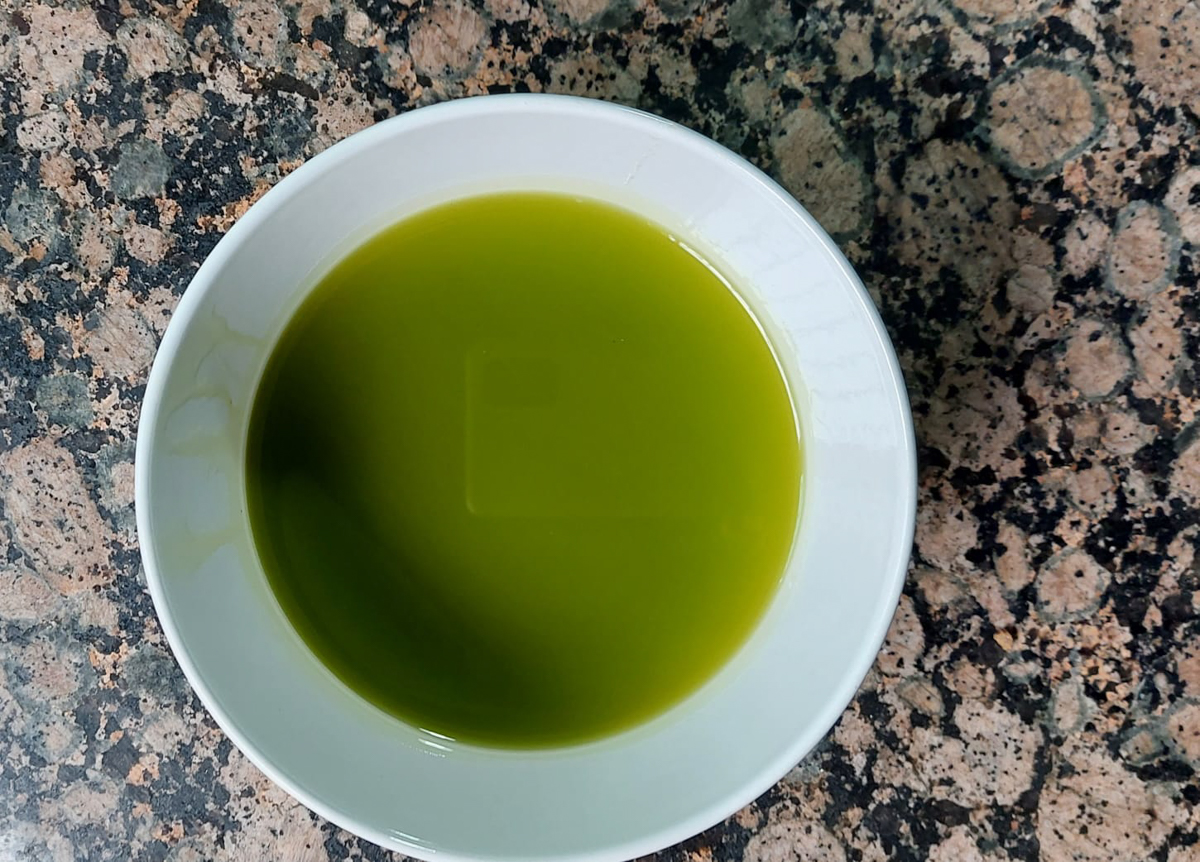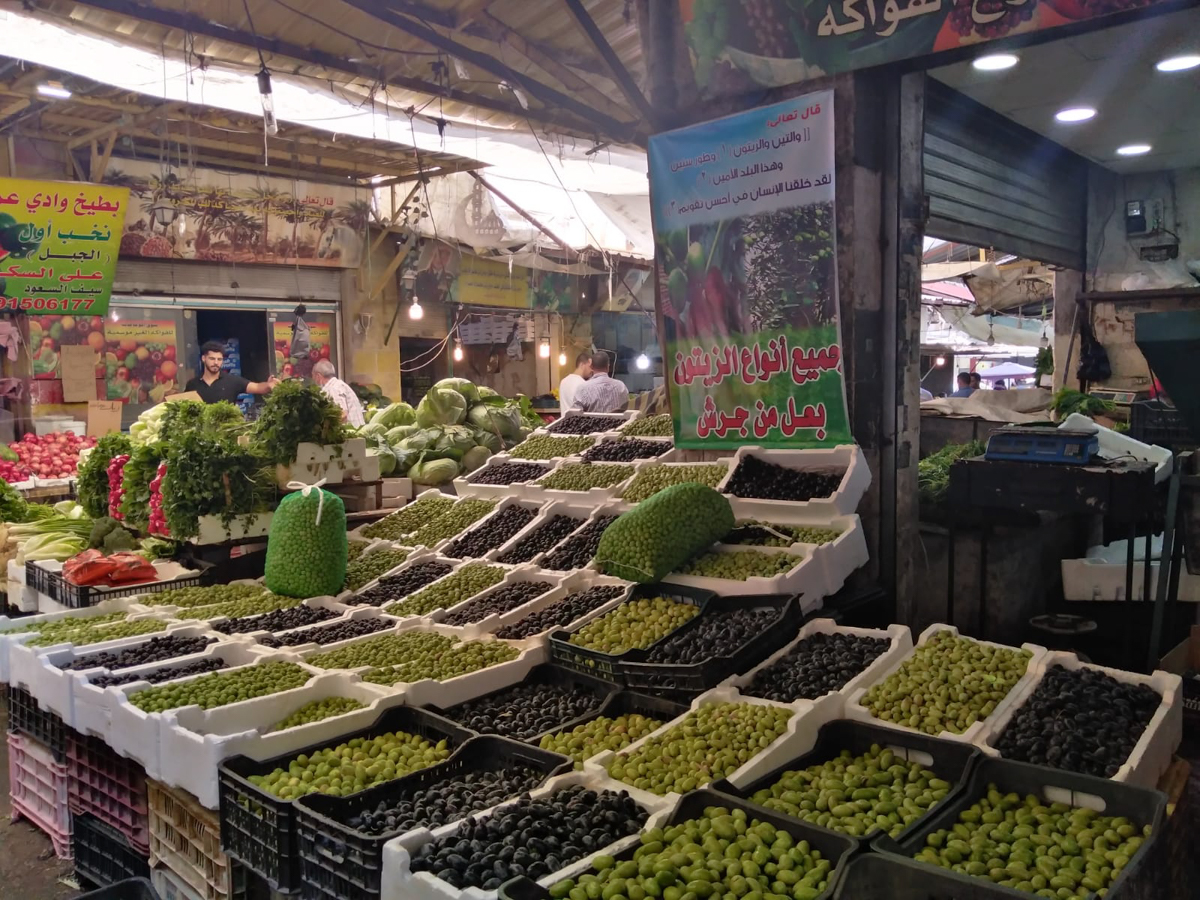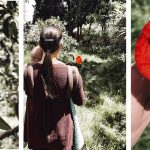Photo by Isabelle Bernard.
STORY BY HEATHER M. SURLS
PHOTOS BY ISABELLE BERNARD & HEATHER M. SURLS
Outside the northern Jordanian city of Ajloun, I sat cross-legged in Wael Rabadi’s olive grove, stripping ripe olives from just-pruned branches. Looking up from the work in my hands, I could see olive trees and oaks, grapevines and stone walls blanketing the hills in all directions. Eighteen hundred years ago, Rabadi’s ancestors owned this whole area, including the prominent hilltop behind me crowned by the centuries-old Ajloun Castle.
Rabadi, a professor of French language and literature at Al al-Bayt University in Mafraq, owns just 10 dunams of this area now (about two and a half acres). The land he inherited from his father supports around 60 mature olive trees and 50 smaller ones, which he planted in the last two years since returning to his farm before the COVID-19 pandemic struck. This land and its trees are an intrinsic part of Rabadi’s personal and national identity.
While my two American friends and I worked alongside Rabadi, I asked him about a stone house up the hill, which I assumed he was raised in. Rabadi stepped out of an olive tree with pruning clippers in hand, a canvas bucket hat shading his face. “I was raised under the trees,” he said with a smile.
The historical vignettes Rabadi shared while we harvested and during our earlier meeting at his home in Amman illuminated the importance of the olive tree in Jordanian culture. Once a king passed an old man planting an olive tree, he told me. The king said, “Old man, you’re about to die. Why are you planting an olive tree? You won’t eat from it.” The old man replied, “They planted and we ate, so we’ll plant so they’ll eat.”
This tale highlights the longevity of Olea europaea, an evergreen species that requires 10 to 15 years to produce a decent crop but can continue bearing olives for hundreds or even thousands of years. Rabadi described how the species requires very little water, how its roots stretch deep into Jordan’s rocky, red soil and extract moisture lodged in the stones themselves. Rabadi, like other Arabs, calls the olive “holy” and “blessed” because of its religious significance for both Christians and Muslims.

The sun sets behind the olive trees at Rabadi’s farm outside of Ajloun. Photo by Isabelle Bernard.
Research suggests that olives have been cultivated in Jordan since 5400 BC. The Hashemite Kingdom continues to be home to some of the world’s oldest olive trees, which locals call “Roman olives” and can be found in places like Wadi Rayyan. In spite of its small size, Jordan also has ranked among the world’s top 10 producers of olives, in league with olive giants like Spain, Italy, and Tunisia. This year Jordan’s Department of Statistics reported that olive trees cover 72 percent of the Kingdom’s agricultural land, with 10.5 million trees planted.
Though today just a small percentage of Jordanians depend solely on olives for their income, in the past, olive oil was the foundation of the region’s economy. Rabadi said his grandfather exchanged olive oil for his annual supply of sugar, tea, coffee, cardamom, rice, and cigarettes. His grandmother used oil to keep her skin soft and youthful, and his father would drink some every day for its health benefits. Rabadi also remembers how, when he was a boy, his family would sell oil to buy bread or eggs or schoolbooks.
“In the past, everything waited for the olives,” he said. “The wedding waited for the olives. The engagement waited for the olives. Buying clothes and shoes waited for the olives.”
Personally, Rabadi says there’s a “spiritual relationship” between him and his trees. “My father always used to say, ‘It’s clear if you love the tree, it starts to love you.’ There is a relationship. There’s a relationship between you and the tree.” He continued, “When I see a tree like this—blooming and fruitful—I am so happy. So happy. Especially when it’s a tree I’ve planted.”

Green and black olives come from the same tree; green ones are slightly less ripe than their black counterparts, but all are processed together to make olive oil. Photo by Isabelle Bernard.
As we worked in the grove, surrounded by trees weighed down with fruit, Rabadi described traditional olive harvest practices, methods still used today. Traditionally, men would sleep in the fields to protect their crop from thieves, then be in the trees at sunrise, picking and pruning dry or weak branches. The women eventually joined the men with breakfast, then sat on the ground to pluck olives from the trimmed branches. Rabadi mentioned traditional songs people sang at harvest time and how the harvest gathered families around the olive tree.
After about an hour of picking, Rabadi’s wife, Isabelle Bernard, a professor of French language and literature at the University of Jordan, joined us with breakfast: a huge tray loaded with parsley and onion omelets, wedges of flatbread, and sliced cucumbers and tomatoes. We ate in the shade of the tree Rabadi and Bernard had harvested the day before. Even when employing day laborers for 10-15 Jordanian dinar a day (about US $14-21), Rabadi’s cousin, who generally supervises the harvest, needs three to four weeks to complete the work since every olive is picked by hand.
Though the work is monotonous and tiring, Rabadi looks forward to olive picking season, even considering it the beginning of the new year. “You prove to yourself that you are able to plant a tree, and it bears fruit and you eat from it and others besides you,” he said. “You feel successful. It’s like when you get a university diploma. It’s a kind of self-realization.”
After about five hours of picking, during which we harvested two trees, Rabadi took us to one of Jordan’s 132 olive mills, where machinery extracts oil from the olives. The parking lot in front of the warehouse was stacked with 50-kilogram (110-pound) burlap and plastic sacks bulging with olives, guarded by their owners. Rabadi said some would spend the night with their crop rather than leaving it overnight. Having worked at a mill in high school, he would know. He told me how on those workday mornings, they’d bring hot bread and dip it directly in the fresh oil. Jordanians consider this meal better than eating stuffed sheep, he said, because it represents the good of the year.
Inside the mill, which smelled like olive tapenade, workers dumped bags of olives onto a conveyor belt, where the olives were washed and jostled to sift out leaves and dirt. The olives then spilled into a crusher that ground them—pits and all—into a thick, brown paste. After churning for a time, the paste traveled down tubes to a machine that pressed oil and water from it. A few meters away, farmers sat at spigots with shiny, 16-liter tanks and plastic jerry cans, carefully filling them with yellow-green streams of oil.

At the end of a two-hour milling process, a stream of olive oil rewards a year’s labor. It takes 50 kilos of olives to make 8-14 liters of oil. Photo by Heather Surls.
While Western cookbooks and food blogs seem to exaggerate or glorify the role of olive oil in Middle Eastern and Mediterranean cooking, a quick survey among my neighbors in Amman proved that the average Jordanian cook does depend on this staple. Women sent me lists of main dishes they prepare that require olive oil rather than vegetable oil, as well as a variety of salads, side dishes, appetizers, and savory pastries. Traditional Jordanian breakfast demands olive oil: you’ll find it drizzled on plates of hummus, broad beans, and labane (a sour cream-like spread), and in bowls accompanied by za’atar and bread for dipping.
Around this time of year, local news outlets and radio shows buzz with discussions about the price of olive oil, which fluctuates from year to year, depending on factors like supply and whether the government allows imports.
The media also warns against counterfeit oil in terms Westerners would reserve for interpersonal relationships and political intrigue. For example, Jordan’s Food and Drug Administration director, General Hayel Obeidat, said that “maintaining the reputation” of Jordan’s oil should be considered “a national responsibility.”
“The Jordanian olive sector is a source of basic income for many citizens and it contributes greatly to the national economy,” he continued in a November 2019 statement. “The oil produced from it is distinct in quality and taste, and we will not allow anyone to abuse the product or harm its reputation.”
Rabadi said that cheaters try to sell a mix of parsley juice and hot peppers as olive oil. His father always tested the quality of oil before purchase by dipping his finger in it and waiting to ensure it remained completely coated. Any small separations indicate the presence of water mixed with the oil.
“The olive tree is mighty,” Rabadi said. “It doesn’t matter to it if you plow or you don’t plow, if you plow up the weeds or not. It’s not important. But if you want a tree that’s beautiful and fresh and tidy … then it needs a little work.”

Freshly pressed olive oil from Rabadi’s olives glows a bright yellow-green. Photo by Isabelle Bernard.

A variety of olives for sale at a market in downtown Amman. People primarily buy these to make homemade table olives, which involves soaking pierced or crushed olives in containers of water for up to two weeks. People then add salt, lemons, and hot peppers for flavoring, according to their preferences. Photo by Heather Surls.
In addition to serving as Anthrow Circus's assistant editor and proofreader, Heather Surls regularly contributes stories to the site, drawing inspiration from her relationships and experiences in Amman, Jordan. Her reporting and creative work have also appeared in places like Religion News Service, Christianity Today, Hidden Compass,Catamaran, Brevity, River Teeth, and Nowhere. Her first book, a memoir-in-essays about a decade in the Middle East, releases from Lucid Books in Summer 2025.










